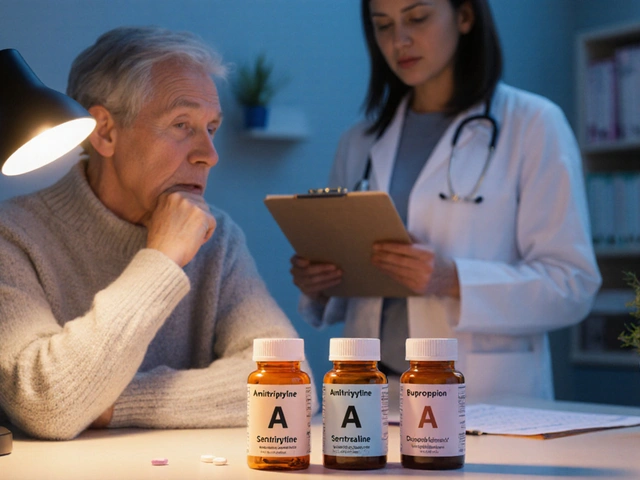5-ASA Medication Comparison Tool
This tool helps you compare key features of different 5-ASA medications used to treat ulcerative colitis.
When doctors talk about keeping ulcerative colitis (UC) in check, Asacol is often the first name they drop. It’s a brand‑name version of Mesalamine, the active ingredient that belongs to the 5‑ASA (5‑aminosalicylic acid) family. The real question most patients face is whether sticking with Asacol makes sense, or if an alternative -‑ sulfasalazine, balsalazide, or olsalazine -‑ could give similar relief with fewer hassles, lower price, or a better safety profile.
Quick Take
- Asacol delivers high‑dose oral mesalamine with a pH‑dependent coating that releases the drug in the colon.
- Sulfasalazine is the oldest 5‑ASA, combines mesalamine with sulfapyridine, and tends to cause more allergic‑type side effects.
- Balsalazide and olsalazine are pro‑drugs that convert to mesalamine in the gut, offering similar efficacy but different dosing schedules.
- Cost gaps are widest in the UK: Asacol’s brand price can be 3‑4× the generic mesalamine cost, while sulfasalazine remains the cheapest.
- Choosing the right pill often hinges on personal tolerance, dosing convenience, and insurance coverage.
How Asacol Works
Asacol’s coating is designed to stay intact until the tablet reaches a pH of 7 or higher - the environment found in the terminal ileum and colon. Once the coating dissolves, mesalamine is released directly onto inflamed mucosa, where it blocks cyclo‑oxygenase and lipoxygenase pathways, reducing prostaglandin and leukotriene production. The result is less inflammation, fewer bloody stools, and a lower chance of flare‑ups.
Key Alternatives Overview
Every alternative still belongs to the 5‑ASA class, but they differ in chemistry, delivery, and side‑effect baggage.
- Sulfasalazine mixes mesalamine with sulfapyridine. The latter is absorbed systemically, which explains why patients sometimes report rash, fever, or joint pain.
- Balsalazide links mesalamine to an inert carrier that only splits in the colon, keeping systemic exposure low.
- Olsalazine joins two mesalamine molecules with a simple bond; gut bacteria break it apart, delivering twice the dose in one tablet.
All three alternatives are available in oral and, for some, rectal forms. Rectal suppositories or enemas (Rectal 5‑ASA) can be added for distal disease, but that’s a separate decision.

Side‑Effect Profile Comparison
Side effects often dictate whether a patient can stay on a medication long‑term. Below is a snapshot of how the four drugs stack up.
| Medication | Formulation | Common GI Issues | Systemic Risks | Typical Cost (UK, per month) |
|---|---|---|---|---|
| Asacol | pH‑dependent coated tablet (2.4‑g daily) | Nausea, headache | Low - no sulfapyridine | £150‑£180 |
| Sulfasalazine | Standard tablet (2‑g daily) | Diarrhea, abdominal cramps | Rash, fever, hemolytic anemia (sulfapyridine) | £30‑£45 |
| Balsalazide | Enteric‑coated tablet (1.5‑g daily) | Mild nausea, flatulence | Very low - no sulfapyridine | £120‑£140 |
| Olsalazine | Tablet delivering 1‑g mesalamine (twice daily) | Headache, mild abdominal pain | Low - occasional renal impairment | £100‑£130 |
Notice how sulfasalazine’s systemic risks stand out because of the sulfapyridine component. If you’ve ever had a drug allergy, that’s the first alternative to question.
Cost & Insurance Considerations
In the UK’s NHS framework, most 5‑ASA drugs are listed on the British National Formulary (BNF). Generic mesalamine is usually the cheapest, but brand‑name Asacol enjoys a “specials” status that sometimes speeds up approval for severe cases. Private insurance plans often negotiate bulk discounts for sulfasalazine, making it the go‑to when cost is the main driver.
For patients on a tight budget, the first step is to ask the pharmacist about the generic version of mesalamine (often sold as “Mesalazine”). It delivers the same active ingredient at roughly a third of Asacol’s price. However, the generic’s release mechanism can differ, which may affect how well it coats the colon.
Choosing the Right 5‑ASA for You
Every UC patient walks a slightly different path. Here’s a quick decision‑tree you can run through with your gastroenterologist:
- Do you have a history of drug allergies or sulfa‑related reactions? If yes, skip sulfasalazine.
- Is your disease limited to the left side of the colon? Consider adding a rectal 5‑ASA formulation.
- Do you prefer a once‑daily pill? Asacol or balsalazide fit the bill; olsalazine requires twice‑daily dosing.
- What does your insurance cover? Check the NHS formulary or private plan list for the lowest‑cost option that meets your dosing needs.
- How sensitive are you to gastrointestinal upset? Start low, monitor, then adjust dose; some patients tolerate balsalazide better than Asacol.
Ultimately the best drug is the one you can stick with without side effects, and that fits your wallet. Switching between 5‑ASA agents is common; studies show no loss of efficacy when patients move from one to another, as long as the total mesalamine dose stays in the therapeutic range (2‑4g per day for moderate disease).
Bottom Line
If you value a predictable once‑daily schedule and can manage the higher price tag, Asacol remains a solid choice. If you’re budget‑conscious or have a sulfa allergy, balsalazide, olsalazine, or generic mesalamine give comparable control with fewer systemic worries. Sulfasalazine works well for mild cases but its side‑effect profile makes it a second‑line pick for many.
Talk to your clinician about the trade‑offs, get the latest pricing from your pharmacy, and keep a symptom diary during any switch. That practical data will guide you to the 5‑ASA that actually works for you.

Frequently Asked Questions
Can I take Asacol and a generic mesalamine at the same time?
Mixing two mesalamine sources rarely adds benefit and can increase the risk of nausea. Most doctors advise using one formulation only, adjusting the dose to stay within the 2‑4g daily range.
Why does sulfasalazine cause rash in some patients?
The sulfapyridine part of sulfasalazine is metabolised systemically and can trigger a hypersensitivity reaction. People with known sulfa allergies are especially prone to rash, fever, or joint pain.
Is it safe to switch from Asacol to balsalazide mid‑flare?
A short overlap (3‑5days) is usually recommended to avoid a gap in anti‑inflammatory coverage. Your gastroenterologist will calculate the equivalent mesalamine dose and monitor symptoms closely.
How does olsalazine’s dosing differ from Asacol?
Olsalazine provides two mesalamine molecules per tablet, so the typical regimen is one tablet twice daily. Asacol, by contrast, is taken once daily because its coating ensures a steady release throughout the colon.
Will insurance cover the brand name Asacol?
Many NHS trusts list Asacol as a “special” when disease severity warrants it, but private insurers often require a step‑therapy trial of cheaper generics first. Always check the formulary and ask your pharmacist about any co‑pay.



Sharon M Delgado
September 30, 2025 AT 19:44Asacol’s price is insane-£180/month?! I switched to generic mesalamine last year, and my colitis’s been stable. The coating’s a little different, sure, but I didn’t notice a difference in flares. Also, my pharmacist said the NHS lets you get it for £45 if you ask for the unbranded version.
Carl Lyday
October 1, 2025 AT 03:46My GI told me the same thing-generic mesalamine works just as well if you take it consistently. I tried sulfasalazine once, and within three days I had a rash and felt like I’d been hit by a truck. Balsalazide was my sweet spot: once daily, no sulfapyridine, and my stomach didn’t revolt. If you’re allergic to sulfa, don’t even test it. Your body will thank you.
Tom Hansen
October 2, 2025 AT 02:37Donna Hinkson
October 3, 2025 AT 16:54I’ve been on mesalamine for seven years. I started with Asacol, moved to balsalazide after a minor kidney scare, and now I’m on the generic. The key for me was tracking symptoms daily. I didn’t realize how much my bloating improved until I compared logs. Small changes matter.
Rachel M. Repass
October 4, 2025 AT 10:53Let’s not romanticize the 5-ASA class like it’s some holy grail-these are anti-inflammatories with narrow therapeutic windows and variable bioavailability. The real question isn’t ‘which pill?’ but ‘which pharmacokinetic profile aligns with your mucosal inflammation pattern?’
Asacol’s pH-dependent release is elegant, yes, but if your disease is proximal, you’re wasting half the dose. Olsalazine’s dimeric structure ensures distal delivery, but if you’re prone to diarrhea, it’s a double-edged sword. And let’s not forget the gut microbiome’s role in prodrug activation-balsalazide’s cleavage is bacterial, so antibiotics? Not ideal.
Insurance? That’s a structural violence issue. We’re treating chronic immune dysregulation with cost-driven formularies. It’s not patient-centered care-it’s actuarial triage.
Arthur Coles
October 4, 2025 AT 10:58Did you know the FDA approved Asacol in 2001 after a 14-month review? But the generic? Approved in 2007 with a 3-month review. Coincidence? Or did the pharma lobby delay generics long enough to lock in profits? I’ve seen patients on Asacol for years-then their insurance drops it, and they’re switched to a generic that gives them migraines and bloody stools.
It’s not about efficacy. It’s about who gets to control your treatment. And trust me-those ‘equivalent’ generics? Sometimes they’re made in plants with zero FDA oversight. You’re gambling with your colon.
Kristen Magnes
October 6, 2025 AT 05:14YOU CAN DO THIS. I was on Asacol for two years, spent £180/month, felt like a zombie from nausea-then I switched to olsalazine. Twice daily? Yes. But my flares dropped by 70%. I started journaling: food, meds, stress, bowel movements. Found a pattern. Talked to my GI. Changed my dose. Now I’m in remission. You’re not broken-you’re just waiting for the right fit. Don’t give up. You got this.
adam hector
October 6, 2025 AT 07:04People think mesalamine is just a pill. But it’s not. It’s a system. A corporate system. Asacol? Made by Repligen. They own patents. They own doctors. They own formularies. The ‘generic’? Often made by the same company under a different label. The real difference? The marketing budget. You’re paying for the logo, not the medicine.
And don’t get me started on the ‘sulfasalazine is dangerous’ narrative. It’s been used since 1938. The real danger? Being told you need the most expensive option because your doctor got a free lunch from a rep.
Ravi Singhal
October 7, 2025 AT 02:41Fay naf
October 7, 2025 AT 08:38Asacol’s ‘pH-dependent coating’? That’s just a fancy way of saying ‘we added a shell so you can’t crush it and save money.’ The same active ingredient in a cheaper pill? They call it ‘inferior.’ But here’s the truth-your colon doesn’t care if it’s branded or not. It just wants the drug. The rest is corporate theater.
ANTHONY SANCHEZ RAMOS
October 8, 2025 AT 13:29Just switched from Asacol to balsalazide last month and OMG it’s a game changer 😊 My stomach stopped acting like a stormy sea 🌊 and I’m actually sleeping through the night now! Also saved like £80/month. My pharmacist said the generic mesalamine is basically the same, but balsalazide just feels gentler? Maybe the carrier molecule? Anyway-YMMV but try it if you’re struggling!
Matt Czyzewski
October 10, 2025 AT 01:49The 5-ASA class represents a fascinating intersection of pharmacokinetics and pathophysiology. The colon’s unique luminal environment-pH, microbial flora, transit time-creates a biological filter that determines drug activation. Asacol’s enteric coating exploits the ileocolonic pH gradient, whereas balsalazide relies on azoreductase enzymes produced by anaerobic bacteria. This distinction is not trivial; it reflects an evolution from passive delivery to bioactivated targeting.
Yet, we reduce this complexity to a cost-benefit spreadsheet. The real tragedy is not the price disparity-it’s the epistemic poverty of clinical decision-making when pharmaceutical economics supersedes physiological nuance.
John Schmidt
October 11, 2025 AT 17:13Everyone’s talking about ‘equivalent’ doses. But what if the ‘equivalent’ is a lie? What if the generic mesalamine doesn’t dissolve in the same way? What if the coating is thinner? What if the tablet breaks apart in your stomach and you’re getting a systemic dose instead of localized? You think your doctor knows? They’re reading a formulary, not a lab report.
I’ve seen patients crash after switching. One guy ended up in the ER with toxic megacolon. They blamed ‘non-compliance.’ I blame the system. And I’m not paranoid-I’m informed.
Victoria Arnett
October 12, 2025 AT 22:15HALEY BERGSTROM-BORINS
October 13, 2025 AT 13:15Asacol is patented until 2027? Actually, no-it expired in 2018. But the FDA approved a new formulation with a ‘modified release’ and gave it a new patent. That’s called evergreening. They didn’t improve the drug-they just changed the pill shape and called it new. Your insurance is being manipulated. You’re not getting a better drug-you’re getting a legal loophole.
Dr. Marie White
October 14, 2025 AT 08:15I’m a gastroenterologist, and I’ve prescribed all four of these. The truth? There’s no ‘best’-only ‘best for you.’ I’ve had patients who tolerate sulfasalazine fine and swear by it. Others break out in hives from the smallest dose. The table’s helpful, but real-world data comes from listening. Ask about sleep, appetite, fatigue-not just bowel movements.
And if cost is a barrier? I’ve written letters to insurers for generics for years. They’re not always denied. Sometimes, you just have to ask. Your voice matters.